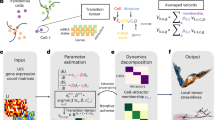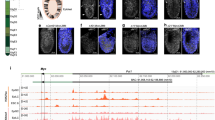Abstract
Distinct modes of ERK activation, sustained or transient, are essential for cell fate decision in cultured cells. Here we show that Xenopus laevis Sprouty2 (XSpry2) controls the duration of ERK activity and thereby contributes to the establishment of dorsoventral patterning during mesoderm formation. Furthermore, Xenopus Fos (XFos) can function as a molecular sensor of the ERK signalling duration in Xenopus embryos. This work provides the first evidence that regulating the duration of ERK activity contributes to cell fate decisions in the context of the whole organism.
This is a preview of subscription content, access via your institution
Access options
Subscribe to this journal
Receive 12 print issues and online access
$209.00 per year
only $17.42 per issue
Buy this article
- Purchase on Springer Link
- Instant access to full article PDF
Prices may be subject to local taxes which are calculated during checkout


Similar content being viewed by others
References
Chang, L. & Karin, M. Nature 410, 37–40 (2001).
Marshall, C. J. Cell 80, 179–185 (1995).
Kim, H. J. & Bar-Sagi, D. Nature Rev. Mol. Cell Biol. 5, 441–450 (2004).
Mason, J. M., Morrison, D. J., Basson, M. A. & Licht, J. D. Trends Cell Biol. 16, 45–54 (2006).
Hanafusa, H., Torii, S., Yasunaga, T. & Nishida, E. Nature Cell Biol. 4, 850–858 (2002).
Nutt, S. L., Dingwell, K. S., Holt, C. E. & Amaya, E. Genes Dev. 15, 1152–1166 (2001).
Sivak, J. M., Petersen, L. F. & Amaya, E. Dev. Cell 8, 689–701 (2005).
Christen, B. & Slack, J. M. W. Development 126, 119–125 (1999).
Whitman, M. Dev. Cell 1, 605–617 (2001).
Murphy, L. O., Smith, S., Chen, R.-H., Fingar, D. C. & Blenis, J. Nature Cell Biol. 4, 556–564 (2003).
Murphy, L. O. & Blenis, J. Trends Biochem. Sci. 31, 268–275 (2006).
Acknowledgements
We thank Y. Sasai, H. Kuroda, S. Kusakabe, M. Itoh and T. Ishitani for helpful discussion and suggestions. This research was supported by grants from the Ministry of Education, Culture, Sports, Science and Technology of Japan (to K.M., H.H. and E.N.).
Author information
Authors and Affiliations
Contributions
H.H. designed and performed the experiments; H.H., K.M. and E.N. analysed the data and wrote the paper.
Corresponding authors
Ethics declarations
Competing interests
The authors declare no competing financial interests.
Supplementary information
Supplementary Information
Supplementary Information (PDF 1035 kb)
Rights and permissions
About this article
Cite this article
Hanafusa, H., Matsumoto, K. & Nishida, E. Regulation of ERK activity duration by Sprouty contributes to dorsoventral patterning. Nat Cell Biol 11, 106–109 (2009). https://doi.org/10.1038/ncb1820
Received:
Accepted:
Published:
Issue Date:
DOI: https://doi.org/10.1038/ncb1820
This article is cited by
-
Sprouty2 regulates positioning of retinal progenitors through suppressing the Ras/Raf/MAPK pathway
Scientific Reports (2020)



